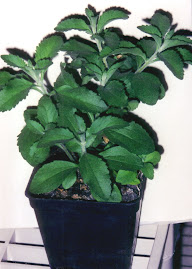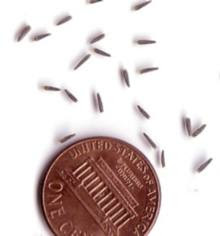
Following is an excerpt from Growing and Using Stevia: The Sweet Leaf from Garden to Table with 35 Recipes
Whole Dried Stevia Leaves are ready for making herbal tea alone or in combination with other herbs. Mint or chamomile leaves go nicely with Stevia. Most herbal teas are better with the addition of Stevia leaves. Whole Dried Stevia Leaves may be purchased if you run out of home-grown leaves. Check the appendix for sources. If you feel a little more ambitious, following are a couple of ways to make further use of homegrown or purchased Dried Stevia Leaves. Recipes in chapter 9 make use of Stevia Leaf Water Extract and Green Stevia Powder
Stevia Leaf Water Extract yields about ½ cup extract
This liquid extract is made from dried leaves. Alcohol or glycerin extracts are available for purchase, but we prefer this water extract which keeps about a week in the refrigerator.
· ½ cup Dried Stevia Leaves, packed in the measuring cup
· 1 cup water
Bring water to a simmer in a small saucepan. Small bubbles should come to the surface. Stir in Dried Stevia Leaves, turn off heat, and cover the pan. Steep 40 minutes. Store in a very clean glass jar. Cover with a lid and refrigerate. Use within a week.
(continued below)
Green Stevia Powder yields about 1/3 cup powder
The most versatile Stevia product from homegrown plants, you’ll find recipes using Green Stevia Powder in this book and more in “Stevia Sweet Recipes: Sugar-Free―Naturally!” by Jeffrey Goettemoeller. Green Stevia Powder is also available for purchase at some natural food stores or online (see appendix).
· 2 cups Dried Stevia Leaves, packed down in the measuring cup
Place dried stevia leaves in a blender bowl and cover while blending on high speed for 30 seconds. Leave bowl covered a few minutes, allowing dust to settle inside. Remove cover and stir with a rubber or plastic spatula, then put cover back on and blend another 30 seconds at high speed.
Alternatively, this first step may be done with a flour sifter or mortar and pestle, in the absence of electricity or an electric blender. With a flour sifter, put in a handful of leaves at a time, cover, and turn the handle until most leaf material has disintegrated and fallen through the screen. Throw out any remaining leaf veins or debris. When using a mortar and pestle, thoroughly grind a few leaves at a time.
Regardless of the grinding method, the powder may be used in recipes at this point if desired, or sift through a tea strainer to remove larger particles still remaining. This removes some tough leaf veins that resist dissolving and don’t taste as good.
For long term storage, put the powder in a glass jar with a tight lid and keep in a dark place. It stores at least 2 years this way without flavor loss. Short term, Green Stevia Powder may be stored in a re-closeable plastic bag kept in a dark location. In general, 3–4 teaspoons of Green Stevia Powder replace a cup of refined sugar.
Order your own copy of Growing and Using Stevia from these vendors:
Click here to order directly from Prairie Oak Publishing.
Click here to order from Amazon.com.
###
Whole Dried Stevia Leaves are ready for making herbal tea alone or in combination with other herbs. Mint or chamomile leaves go nicely with Stevia. Most herbal teas are better with the addition of Stevia leaves. Whole Dried Stevia Leaves may be purchased if you run out of home-grown leaves. Check the appendix for sources. If you feel a little more ambitious, following are a couple of ways to make further use of homegrown or purchased Dried Stevia Leaves. Recipes in chapter 9 make use of Stevia Leaf Water Extract and Green Stevia Powder
Stevia Leaf Water Extract yields about ½ cup extract
This liquid extract is made from dried leaves. Alcohol or glycerin extracts are available for purchase, but we prefer this water extract which keeps about a week in the refrigerator.
· ½ cup Dried Stevia Leaves, packed in the measuring cup
· 1 cup water
Bring water to a simmer in a small saucepan. Small bubbles should come to the surface. Stir in Dried Stevia Leaves, turn off heat, and cover the pan. Steep 40 minutes. Store in a very clean glass jar. Cover with a lid and refrigerate. Use within a week.
(continued below)
Green Stevia Powder yields about 1/3 cup powder
The most versatile Stevia product from homegrown plants, you’ll find recipes using Green Stevia Powder in this book and more in “Stevia Sweet Recipes: Sugar-Free―Naturally!” by Jeffrey Goettemoeller. Green Stevia Powder is also available for purchase at some natural food stores or online (see appendix).
· 2 cups Dried Stevia Leaves, packed down in the measuring cup
Place dried stevia leaves in a blender bowl and cover while blending on high speed for 30 seconds. Leave bowl covered a few minutes, allowing dust to settle inside. Remove cover and stir with a rubber or plastic spatula, then put cover back on and blend another 30 seconds at high speed.
Alternatively, this first step may be done with a flour sifter or mortar and pestle, in the absence of electricity or an electric blender. With a flour sifter, put in a handful of leaves at a time, cover, and turn the handle until most leaf material has disintegrated and fallen through the screen. Throw out any remaining leaf veins or debris. When using a mortar and pestle, thoroughly grind a few leaves at a time.
Regardless of the grinding method, the powder may be used in recipes at this point if desired, or sift through a tea strainer to remove larger particles still remaining. This removes some tough leaf veins that resist dissolving and don’t taste as good.
For long term storage, put the powder in a glass jar with a tight lid and keep in a dark place. It stores at least 2 years this way without flavor loss. Short term, Green Stevia Powder may be stored in a re-closeable plastic bag kept in a dark location. In general, 3–4 teaspoons of Green Stevia Powder replace a cup of refined sugar.
Order your own copy of Growing and Using Stevia from these vendors:
Click here to order directly from Prairie Oak Publishing.
Click here to order from Amazon.com.
###




2 comments:
Is it possible to process the leaves to make the white powder that is purchased in stores? Is this explained in your book?
Kathleen, thanks for the question. The answer is no. It's not feasible to produce the white stevia powder in a home setting. The process for filtering out the sweet glycosides it pretty involved. The green powder works in many recipes, and this is as far as you can go with processing stevia yourself.
Post a Comment